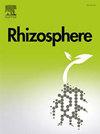ahl驱动的根际微生物、酶和养分级联是连作木麻黄生长下降的原因之一
IF 3.4
3区 生物学
Q1 PLANT SCIENCES
引用次数: 0
摘要
酰基高丝氨酸内酯(Acyl homoserine lactones, AHL)是革兰氏阴性菌群体感应(quorum sensing, QS)信号分子,在调节植物生长和塑造根际生态系统中发挥着重要作用。本研究研究了澳大利亚木麻黄科(Casuarina equisetifolia)多代连续种植对其根际土壤AHL积累的影响。本研究旨在确定关键AHL,并进一步采用外源补充方法评估其对马针叶生长和相关根际土壤生态系统的影响。结果表明,随着种植世代的增加,总AHL含量逐渐增加,从1.76 ng/g增加到3.65 ng/g。在连作条件下显著改变根际土壤性质的关键AHL为C4-HSL、3-oxo-C10-HSL、3-oxo-C12-HSL和3-oxo-C14-HSL。外源处理C4-HSL后,C4-HSL浓度的增加与马叶松根长和株高的显著增加相关。相反,3-oxo-C10-HSL、3-oxo-C12-HSL和3-oxo-C14-HSL处理导致这些生长参数显著降低。虽然所有4个关键AHL都对土壤真菌和放线菌的增殖有积极的贡献,但它们对细菌种群的影响表现出变异性。外源施用4种关键AHL后,土壤脲酶和蛋白酶活性显著降低。酸性磷酸酶和纤维素酶活性增强,导致土壤速效氮、钾含量降低,速效磷含量升高。交互效应分析表明,这些关键AHL共同对土壤微生物丰度具有较强的正向调节作用(0.979∗∗)。土壤微生物与土壤酶活性呈显著正相关(0.997∗∗),而土壤酶活性与土壤速效养分含量呈显著负相关(- 0.995∗∗)。此外,土壤速效养分含量正调控了马叶松的生长(0.970 * *)。连作对木贼叶生长的抑制作用主要源于根际3-oxo-C10-HSL水平的降低和根际3-oxo-C12-HSL和3-oxo-C14-HSL浓度的升高。这种变化导致土壤细菌数量的减少,显著降低了土壤脲酶和蛋白酶的活性,也降低了马针叶根际氮和钾的有效性。因此,这些变化导致木贼的根长和干重明显减少。本研究为外源应用AHL调控森林生态系统中马针叶生长提供了重要的理论框架。本文章由计算机程序翻译,如有差异,请以英文原文为准。

The AHL-driven cascade of rhizosphere microbes, enzymes, and nutrients contributes to the growth decline of Casuarina equisetifolia in continuous planting systems
Acyl homoserine lactones (AHL), which are extensively studied quorum sensing (QS) signaling molecules in Gram-negative bacteria, play a significant role in regulating plant growth and shaping the rhizosphere ecosystem. In this study, we investigated the effects of continuous planting across multiple generations of the Australian pine Casuarina equisetifolia (Casuarinaceae) on AHL accumulation in its rhizosphere soil. The study aims to identify key AHL and further employs an exogenous supplementation approach to assess their influence on the growth of C. equisetifolia and the associated rhizosphere soil ecosystem. Our findings reveal a progressive increase in total AHL content, rising from 1.76 to 3.65 ng/g with continuous planting generations. The key AHL that significantly alter rhizosphere soil properties under continuous planting conditions are identified as C4-HSL, 3-oxo-C10-HSL, 3-oxo-C12-HSL, and 3-oxo-C14-HSL. Following exogenous treatment with C4-HSL, an increase in its concentration was correlated with a significant enhancement in both the root length and plant height of C. equisetifolia. Conversely, treatments with 3-oxo-C10-HSL, 3-oxo-C12-HSL, and 3-oxo-C14-HSL resulted in a significant reduction in these growth parameters. While all four key AHL contributed positively to the proliferation of soil fungi and actinobacteria, their effects on bacterial populations exhibited variability. Following the exogenous application of the four key AHL, a significant reduction in the activities of urease and protease in the soil was observed. In contrast, the activities of acid phosphatase and cellulase were enhanced, leading to a decrease in the soil's available nitrogen and potassium content, while the available phosphorus content increased. Interaction effect analysis reveals that these key AHL collectively exert a strong positive regulatory effect on soil microbial abundance (0.979∗∗). Furthermore, soil microorganisms show a significant positive correlation with soil enzyme activity (0.997∗∗), whereas soil enzyme activity exhibits a strong negative correlation with the soil's available nutrient content (−0.995∗∗). Additionally, the soil's available nutrient content positively regulates the growth of C. equisetifolia (0.970∗∗). The inhibitory effect of continuous planting on C. equisetifolia growth primarily stems from reduced 3-oxo-C10-HSL levels coupled with elevated 3-oxo-C12-HSL and 3-oxo-C14-HSL concentrations in the rhizosphere. This alteration leads to a decrease in the bacterial population within the soil, which significantly reduces the activities of soil urease and protease, as well as the availability of nitrogen and potassium in the rhizosphere of C. equisetifolia. Consequently, these changes result in markedly diminished root length and dry weight of C. equisetifolia. This study provides a critical theoretical framework for the exogenous application of AHL to modulate C. equisetifolia growth in forest ecological system.
求助全文
通过发布文献求助,成功后即可免费获取论文全文。
去求助
来源期刊

Rhizosphere
Agricultural and Biological Sciences-Agronomy and Crop Science
CiteScore
5.70
自引率
8.10%
发文量
155
审稿时长
29 days
期刊介绍:
Rhizosphere aims to advance the frontier of our understanding of plant-soil interactions. Rhizosphere is a multidisciplinary journal that publishes research on the interactions between plant roots, soil organisms, nutrients, and water. Except carbon fixation by photosynthesis, plants obtain all other elements primarily from soil through roots.
We are beginning to understand how communications at the rhizosphere, with soil organisms and other plant species, affect root exudates and nutrient uptake. This rapidly evolving subject utilizes molecular biology and genomic tools, food web or community structure manipulations, high performance liquid chromatography, isotopic analysis, diverse spectroscopic analytics, tomography and other microscopy, complex statistical and modeling tools.
 求助内容:
求助内容: 应助结果提醒方式:
应助结果提醒方式:


